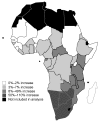Malaria attributable to the HIV-1 epidemic, sub-Saharan Africa
- PMID: 16229771
- PMCID: PMC3310631
- DOI: 10.3201/eid1109.050337
Malaria attributable to the HIV-1 epidemic, sub-Saharan Africa
Abstract
We assessed the impact of HIV-1 on malaria in the sub-Saharan African population. Relative risks for malaria in HIV-infected persons, derived from literature review, were applied to the HIV-infected population in each country, by age group, stratum of CD4 cell count, and urban versus rural residence. Distributions of CD4 counts among HIV-infected persons were modeled assuming a linear decline in CD4 after seroconversion. Averaged across 41 countries, the impact of HIV-1 was limited (although quantitatively uncertain) because of the different geographic distributions and contrasting age patterns of the 2 diseases. However, in Botswana, Zimbabwe, Swaziland, South Africa, and Namibia, the incidence of clinical malaria increased by < or =28% (95% confidence interval [CI] 14%-47%) and death increased by < or =114% (95% CI 37%-188%). These effects were due to high HIV-1 prevalence in rural areas and the locally unstable nature of malaria transmission that results in a high proportion of adult cases.
Figures



References
-
- World Health Organization. Malaria and HIV/AIDS interactions and implications: conclusions of a technical consultation convened by WHO; 2004 23–25 June. Report no.: WHO/HIV/2004.08. Geneva; 2004.
Publication types
MeSH terms
LinkOut - more resources
Full Text Sources
Medical
Research Materials
